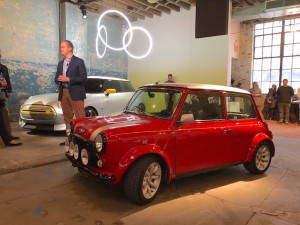
With one axle in the past and one in the present, this Mini concept is all about the company's electrified future products.
At this year’s New York International Auto Show, Mini has one axle in the past, the other in the future as it rolls out its retro-styled Electric Concept.
At first glance, you might think you were looking at a ’60s-era micro-car. But a closer look reveals the charging plug used to power up the concept’s all-electric drivetrain. The NYIAS show car is meant to “pave the way,” the British maker suggests, for Mini’s first all-electric production vehicle, which it plans to roll out next year.
The brand has been tinkering with electric propulsion for more than a decade, first plugging in with the 2008 Mini E. Based on the last-generation Mini 3-door, only 600 copies were produced for a field test of the drivetrain and to gauge consumer response. It served as the foundation for the development of parent BMW’s own all-electric i3 city car.
That model has made it clear there’s a potential strong market in central cities for compact, all-electric vehicles, according to industry analysts, especially as improved battery technology is introduced capable of boosting range, while reducing charging times and dropping costs.
(Mini upgrades the mite that started it all for 2018. Click Here for the story.)
When the Mini E was introduced, lithium-ion batteries cost around $1,000 a kilowatt-hour. That’s now down below $200 and expected to reach $70 or so before the mid-2020s. To put that into perspective, a 60 kWh battery pack capable of delivering around 250 miles of range for a car like the Mini Electric has already dropped from around $60,000 to $12,000. And it should plunge to barely $4,200 over the life of the production Mini Electric.
For the moment, Mini isn’t saying much about the actual Electric model’s technology, beyond promising “innovative zero-local emission technology.” (That’s an acknowledgement that battery power actually moves some level of pollution from the vehicle tailpipe to the generating plant’s smokestack.)
If the Mini Electric concept provides any hints, it appears to be powered by a single electric motor, and Mini suggests it has the brand’s classic “go-kart feeling.”
(Click Here for more about making your Mini your own with new personalization program.)
That’s not surprising. Electric motors produce tremendous amounts of torque – which comes on the moment they start spinning, unlike internal combustion engines that first have to rev up. So an all-electric powertrain could actually do well in terms of delivering Mini-like manners.
If some of what parent BMW has been working on holds true for its British subsidiary, we can expect to see the production Mini Electric charge up in less than four hours on a standard, Level 2 charging system, while it could cut that to under 30 minutes using one of the fast Level 3+ chargers BMW is working on.
One of the few details Mini has confirmed is that the production model will roll out of the brand’s plant in Oxford.
As for the little concept debuting in the Big Apple, it started out as an unusually well-preserved version of the marque’s old three-door. Its red body paint is contrasted by a white roof and hood striping. The yellow Mini Electric logo has been worked into the brand logo and wheel hubs.
(For more details about the Mini EV, Click Here.)
Mini parent BMW has committed to electrifying virtually every product in its portfolio and will offer a mix of variants including hybrids, plug-ins and pure battery-electric models For its part, Mini did take a leap into the fast-emerging battery market with the addition of the Countryman ALL4 Plug-In Hybrid.
